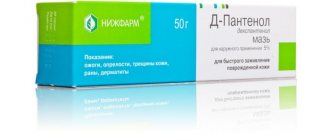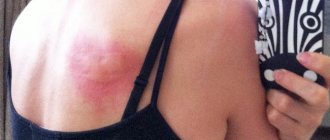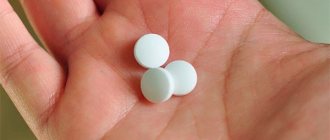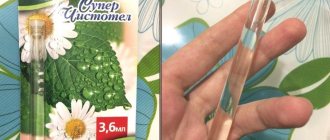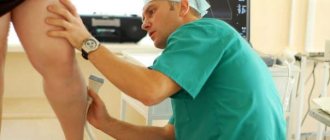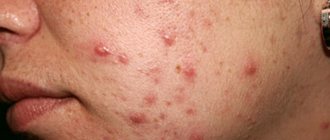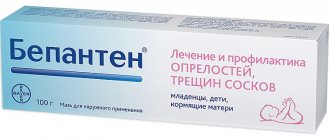The human skin contains a large number of microbes, bacteria and fungi. With good local immunity, they do not pose a threat to health. Elderly people and patients after a stroke or injury cannot take care of themselves. Most often, they are immobilized and do not fully control their body. In people who are bedridden, the condition of the outer skin changes over time, the level of collagen and fat production decreases, which leads to increased sensitivity, thinning and dryness. The skin is easily injured and takes a long time to heal, and the lack of air baths provokes new irritation and the appearance of infections and bedsores. Also, due to impaired motor function, blood stagnation occurs, as a result of which bedridden patients are diagnosed with diaper rash.
Diaper rash is an inflammatory process that occurs in areas of the skin:
- compressed for a long time;
- constantly rubbing against each other;
- in contact with linen;
- in areas of constant exposure to moisture: urine, sweat, discharge from wounds and ulcers.
Causes
The main factors that provoke the occurrence of diaper rash are:
- excess weight;
- allergic reactions;
- hot weather, poorly ventilated room where the seriously ill patient is located;
- increased blood sugar levels, metabolic disorders in the body;
- immobility;
- lack of hygiene;
- increased sweating;
- enuresis;
- problems with the immune system;
- uncomfortable clothes, incorrectly selected underwear (underwear and bedding).
The right shoes
To prevent diaper rash between and under your toes, you need to choose the right shoes. Walking for a long time in shoes that do not allow air to pass through leads to increased moisture in the feet and increased growth of bacteria. Do not wear rubber boots or boots for a long time. If you have to wear rubber shoes, be sure to use thick cotton socks that absorb moisture well.
Try to air your feet more often, change your shoes and dry your shoes, shoes, boots or sneakers. This will prevent moisture from accumulating on your feet and between your toes. Give preference to shoes made from natural materials.
There are special insoles for both winter boots and summer sandals that absorb sweat and provide comfort while walking. They should be used when you are treating diaper rash. They prevent skin redness from developing, absorb odor, and reduce leg fatigue.
Stages of development and localization
There are 3 stages of progression of diaper rash:
- Initial: redness, itching, no visible damage to the outer layer.
- Moderate: ulceration.
- Severe: deep non-healing bloody cracks, unpleasant odor and an increase in the affected area.
Places of formation of the disease:
- neck;
- armpits;
- under the breasts in women, in the groin (in men);
- palms, behind the ears;
- buttocks, abdominal folds, tailbone;
- on the foot between the toes.
Preventive measures
Diaper rash can occur in anyone: newborns, children, adult men, women. However, their occurrence can be prevented by following these simple steps:
Choose shoes made from natural materials. Avoid wearing rubber shoes; Moisturize the skin of your hands and feet, as well as the space between your fingers; Maintain personal hygiene; Avoid wearing clothes and underwear made of synthetic materials; Be extremely careful when going to beauty salons, swimming pools, saunas.
The toes are located quite tightly, so sometimes diaper rash occurs in these places. Elderly, sick and overweight people especially often suffer from diaper rash between the toes. How to deal with the problem so that it does not develop into a more serious skin lesion?
Symptoms
Manifestations of diaper rash are as follows:
- Redness of the affected skin area.
- Swelling of the pathological area and moisturizing of the skin on it.
- Unbearable severe itching and burning of dry skin.
- Painful sensations.
Symptoms of the pathological process develop rapidly, literally within a few hours. Initially, erythema appears in the skin fold. Then cracks, erosions and weeping appear.
Treatment of feet with various means
It is important to notice diaper rash in time to prevent the formation of wounds and the proliferation of bacteria. Remember that treatment of diaper rash at an early stage is much easier than in advanced cases.
If your feet sweat or get wet, wash them with antibacterial soap, rinse with water and dry gently with a towel. Do not rub your skin too much. For drying, you can use a hair dryer set to cool. Baby powder or talc perfectly absorbs moisture, so they powder the feet and the space between the toes. You can use an infrared lamp, which will dry the skin and improve blood circulation. To prevent diaper rash, wash your feet with a boric acid solution. For one glass of water take 1 small spoon of boric acid. After washing the skin, dry it carefully.
Particularly affected by diaper rash between the toes are people who cannot reach the soles of their feet on their own. They need to be provided with appropriate care. The nurse or assistant should wash the feet and carefully dry the skin between and under the toes. Having noticed diaper rash, the skin should be lubricated with cream with calendula or chamomile.
You can make baths from a decoction of calendula or oak bark. They will help reduce sweating, disinfect the skin, and promote wound healing. After the baths, your feet and toes must be thoroughly dried. It is easier to prevent diaper rash than to subsequently carry out treatment, which can take a long time.
Complications
In the absence of appropriate timely treatment for diaper rash, cracks and bleeding non-healing ulcers form in the affected areas, and the skin becomes covered with a gray-brown coating that emits a putrid odor. When bacteria enter open wounds, the disease becomes chronic. The patient constantly experiences itching, burning and severe pain in the areas where the ulcers form. The physical and psycho-emotional state of health worsens. In such cases, in order to cure the disease, expensive, potent drugs are prescribed. The most common complications are fungal diseases, streptococcal infections, and athlete's foot.
The right shoes
If you notice diaper rash on your feet, first of all you need to pay special attention to the shoes you are wearing. Wearing rubber shoes for a long time, which do not allow normal air circulation, only provokes the appearance of new bacteria and their active reproduction. If possible, avoid constantly walking in rubber boots; wear high-quality cotton socks underneath that can absorb moisture.
It is also recommended to let your feet breathe as often as possible; When coming to work in winter, change your shoes and be sure to dry your shoes. Such simple actions will prevent moisture from appearing and bacteria from multiplying on the feet.
Try to choose shoes made from natural material. It is also recommended to purchase special, moisture-absorbing insoles for shoes. In addition to the fact that they prevent excessive sweating of the feet and prevent the development of fungal diseases, the surface of the skin does not become damp when worn. They are also great for relieving tired legs.
Return to contents
Prevention measures
You can prevent the development of diaper rash by following these recommendations:
- Observe hygienic care standards. The cleanliness of the outer coverings must be maintained by washing the natural folds using hypoallergenic detergents. Dry the skin completely with a hairdryer.
- Frequent bathing and washing for patients with fecal and urinary incontinence, timely changing of diapers for adults.
- Use underwear and bed linen made from natural fabrics.
- Carefully smooth and remove wrinkles.
- Feed the patient hypoallergenic food.
- It is advisable to regularly expose areas of skin at risk of diaper rash and perform air baths.
- Treat diseases that cause excessive sweating.
- Take courses of vitamin-containing preparations twice a year.
- Avoid friction in the groin and thigh areas, as well as contact with allergens.
- Eliminate provoking factors: fight excess weight, use special pads for urinary incontinence, etc.
- Maintain body hygiene after each trip to the toilet, as well as in the morning and evening, treat wounds on time, change bandages.
- Rotate bedridden patients, placing them on different sides.
If irritation does appear, it should be treated with an antiseptic and a thin layer of ointment or baby cream should be applied.
Treatment methods
Before treating diaper rash, you should determine at what stage of development the disease is.
If the disease is mild, first of all it is necessary to minimize any mechanical impact on the skin of the feet. It is recommended to avoid shoes made from low-quality materials. Diaper rash on the little toe is often caused by tight shoes made of hard materials; in such cases, it is better to opt for loose and soft shoes.
In addition, you need to pay special attention to hygiene: careful care in the interdigital area is quite important. The skin should be washed with warm water and fragrance-free soap. During washing, you can use a small amount of antiseptic. After washing, dry the skin of your feet thoroughly with a towel.
Medical therapy
If interdigital diaper rash occurs, you should consult a doctor promptly. The specialist, having assessed the patient’s condition, will prescribe the necessary antibiotics, antibacterial and medications or special ointments.
In the initial stages of the disease, it is recommended to treat the interdigital folds with baby powder, which dries the skin well. Also, to dry the epidermis, absorb excess sweat and restore blood circulation, a specialist may advise exposing the skin to infrared light.
Treatment with folk remedies
In the initial stages of the disease, folk remedies are quite effective.
Foot baths based on oak bark, calendula, chamomile, celandine or pine needles have an anti-inflammatory effect, soften irritated skin and normalize sweating. It is recommended to do such baths twice a day for 2 weeks.
For an antibacterial effect, you can treat the skin between your fingers with brilliant green, and for softening purposes, sunflower or olive oil is suitable.
Zinc ointment: instructions for use
Pharmacy ointment is available in jars and tubes. The instructions for use of zinc ointment regulate its use for non-purulent skin inflammations. The zinc composition is applied to dermatitis, diaper rash, and bedsores. Attention is focused on the fact that zinc treats those inflammatory processes that are accompanied by the release of exudate
(liquids).
The use of zinc ointment is external. The antibacterial effect of zinc is weak. The ointment does not treat fungal or viral infections . It only dries and allows you to quickly relieve irritation and inflammation. The instructions for the ointment regulate its use for dermatitis, diaper rash, streptoderma, acne, as well as for the treatment of shallow wounds and small cuts .
The use of zinc ointment for children is allowed from the first days of life . It prevents and treats diaper rash that appears in babies after wet diapers. It also relieves irritation that remains on the skin after feces (often with diarrhea and dysbacteriosis - the skin is irritated and sore).
The use of zinc ointment during pregnancy is also allowed . During pregnancy, women use a zinc composition to bleach cosmetic defects (for example, pigmentation)
.
Zinc oxide should not be swallowed , and zinc vapor should not be inhaled. Once inside, this element causes poisoning . Therefore, it is not recommended to use zinc ointment for cracked nipples of a nursing woman. Getting zinc into a child’s food tract can lead to toxic poisoning. External use of the ointment does not lead to the penetration of zinc into the bloodstream and does not cause toxicosis.
Now let’s look at what is treated with zinc ointment. Besides dermatitis and diaper rash, where else does the zinc composition provide benefits?
Zinc oxide
The main active ingredient is zinc oxide. It is he who has an anti-inflammatory and drying effect . Twenty years ago, various mash-ups were prepared in prescription departments, and zinc was included in any ointments for the treatment of dermatitis. Even today, many baby powders and sunscreens contain zinc.
The use of the element for skin treatment has a deep history. In the treatises of ancient healers, zinc was included in many formulations for skin inflammation. In ancient China, women rubbed their faces with a paste containing crushed pearls.
(which also contains zinc). They added it to shadows, powder, and lipstick.
What does this element provide, and why is it so in demand in various skin care creams?
Zinc ointment in cosmetology
Zinc is not called the beauty mineral for nothing. Zinc oxide is included in various cosmetic and pharmaceutical ointments and pastes for the body and face. Zinc ointment for skin is an important component of health and external attractiveness .
What does zinc do for facial skin:
Zinc facial ointment is used for oily skin (remember the drying effect
).
The composition is not used for dry skin types. A zinc ointment mask for dry skin is prepared from zinc oxide, petroleum jelly and cosmetic nourishing oil, baby cream (for example, Johnson Baby
). You can also soften the effect of zinc paste with butter (it is added to the composition instead of cream). At the same time, the anti-inflammatory effect is maintained without drying the skin.
Note: zinc ointment is not used as a makeup base. It can be a night cream, but it cannot be a day cream or foundation.
Analogs
Zinc is a medium-acting antiseptic. It helps relieve irritation, but is not always able to cure inflammation. Severe inflammatory processes and skin infections are treated with similar drugs with a more pronounced effect (Levomekol ointment, Panthenol cream).
When deciding which is better – zinc ointment or Panthenol, consider the cause of skin inflammation. If it is a pathogenic bacterium or a viral infection, the zinc composition will not help you.
Where zinc ointment is ineffective
Since zinc oxide is a medium-acting antiseptic, it is not always able to treat skin inflammation. When it is ineffective:
- Zinc ointment for lichen does not have a therapeutic effect . It can dry out lichen spots, but is not able to limit their spread or prevent the appearance of new spots. Zinc ointment does not help against a fungus (the causative agent of lichen), nor does it help against a virus or pyogenic bacteria.
- Zinc ointment for herpes is ineffective . It can only dry out existing bubbles, but does not radically affect their number and extent of distribution.
- Similarly, zinc ointment for chickenpox is used during the healing stage . When the virus is under control and new rashes stop appearing. During this period, the rash is treated with a skin antiseptic. The use of ointment in the acute stage, when the rash just appears, reduces itching.
Composition of zinc ointment
The basis of zinc ointment is Vaseline. The amount of zinc oxide and petroleum jelly is related as 1:10
.
Various manufacturers add additional components to the main composition - menthol, fish oil, parabens, lanolin, mineral oils, wax
. This determines the additional properties and price of the ointment.
The most affordable cost is for a simple composition (zinc oxide + petroleum jelly). More expensive is an ointment with mineral oils and parabens. Some components (salicylic acid, sulfur) enhance the effect of the ointment.
Zinc and salicylic acid
The composition with salicylic acid is called salicylic-zinc ointment or Lassar paste
.
The composition was invented more than 100 years ago by a dermatologist. It effectively treats acne and skin inflammation and has a noticeable whitening effect .
The salicylic component in the composition is a keratolic, it enhances the antiseptic properties of the paste. The keratolytic properties of salicyl make it possible to use the ointment to soften calluses .
Salicylic acid often causes skin irritation and allergic reactions. Therefore, it is not used during pregnancy and in pediatrics (children under 12 years of age are not treated).
Sulfur and zinc
The composition with the addition of sulfur is called sulfur-zinc ointment
.
When applied to the skin, the sulfur component forms sulfides, which enhance the anti-inflammatory effect . In addition, sulfur is an adsorbent. The combination of sulfur and zinc provides fungicidal and antiparasitic properties of the ointment . This allows the composition to be used for weeping ulcers, purulent eczema, fungal diseases, and scabies.
Complex drugs
This group contains several active substances, which provides a high therapeutic effect. The most effective treatment for diaper rash and itching is:
Ointment "Zhivitsa"
A natural product containing vegetable oils, pine resin and beeswax. It has analgesic, antiviral, anti-inflammatory, decongestant and wound healing effects.
Apply 3-5 times during the day in a thin layer to washed and dry skin.
Vitaon Balsam Karavaeva
A natural herbal preparation containing a mixture of oil extracts of pine buds, rose hips, celandine, St. John's wort, wormwood, thyme and yarrow, fennel and caraway fruits, peppermint leaves, calendula and chamomile flowers. It has an antiseptic, anti-inflammatory and healing effect, activates regenerative processes in the skin, and relieves itching. Apply 2 times a day to affected skin, rubbing lightly.
La Cree cream
A complex combined preparation containing plant extracts, panthenol and bisabolol. It has an anti-allergic, anti-inflammatory, softening, moisturizing and regenerating effect. Apply 2 times a day to dry skin.
Zinc for healthy skin
Zinc is a trace element that is 99% concentrated in the cells of the body, and its highest concentration is in the brain. With a lack of zinc, buffer organs (nails, hair) and skin are primarily affected. To restore it, use zinc-containing formulations (creams and ointments). Zinc ointment is one of the most affordable options for providing the skin with the necessary trace elements.
Interesting: There is a simple test that lets you know if you have enough zinc in your skin. If your wounds heal slowly, it means you don’t have enough zinc.
Diagnostics
Which doctor should I contact: a dermatologist, dermatovenerologist.
To identify the nature of the attached flora, the doctor scrapes the affected areas, takes the discharge of blisters and skin flakes. Based on the results of laboratory tests, a diagnosis is made. Additionally, a biochemical blood test and determination of sugar levels may be required.
Before being examined by a doctor, you should not use any medications yourself, as this may distort the test results. It is also not recommended to visit the bathhouse, sauna, or swimming pool. On the day of the consultation, it is advisable not to wash the affected area.
Doctor about the information content of scrapings https://www.consmed.ru/dermatolog/view/874945/:
